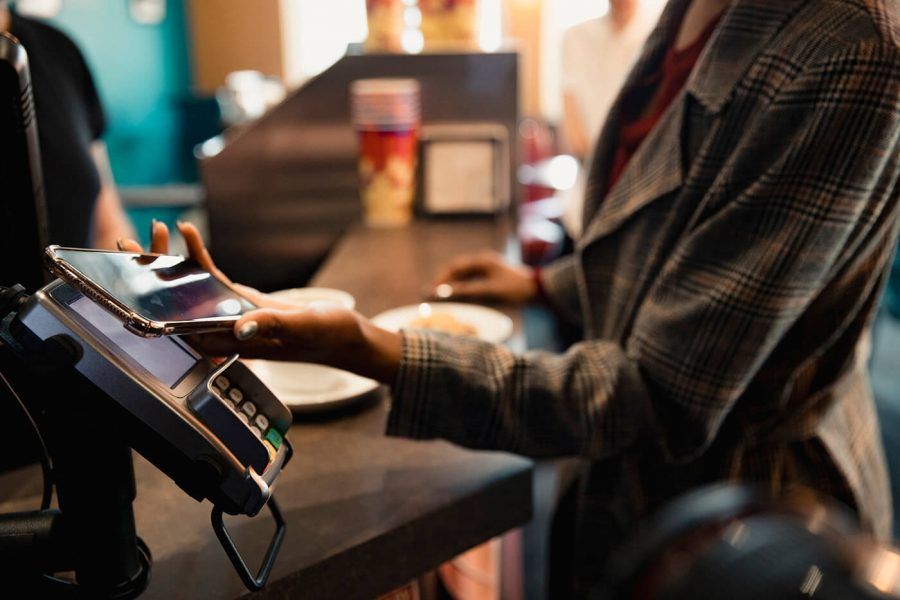In this article:
Contactless pay technology allows consumers to make purchases with debit or credit without inserting a card or handing it to a cashier. It has become ubiquitous in parts of Asia and Europe, though it's been slow to gain traction in the United States.
Your phone or credit cards may already have this feature, and with the COVID-19 pandemic causing us to rethink what we touch, now may be the time to start using it.
How Does Contactless Payment Work?
We're used to swiping our cards or sticking them in a chip reader at the checkout counter, but both payment methods require touching a machine, or in some cases, giving your card to a cashier to insert or swipe it for you.
Contactless payment allows you to bypass that and instead simply hover or tap your card or phone on a reader. The payment is processed quickly via wireless communication and the rest of the transaction proceeds as usual.
Contactless payments are often faster and more convenient for customers and retailers alike, but purchases made in the U.S. are still by and large done "the old way." While U.S. credit card issuers haven't issued as many contactless cards, merchants have been reluctant to adopt the new technology and cardholders may be unsure how to use it.
But it's getting there and is expected to grow as more card issuers have recently begun issuing contactless payment cards and wearable technology that allows contactless payments becomes more widely used. A big step forward for the technology's adoption happened recently when New York City rolled out contactless pay for its public transportation system.
How Do You Use Contactless Payment?
There are two ways you can use contactless payment:
Contactless Card
Some major credit and debit card issuers, such as Chase and Citibank, have started enabling their cards with contactless technology. This lets you tap your card on a contactless reader to pay.
Contactless credit card payments don't require interaction with the payment terminal, but contactless debit cards typically do still require you to enter a PIN. So if your priority is to avoid touching anything, it's best to use a credit card so you can avoid touching the payment terminal. Here is an example of a popular credit card that offers contactless payment:
- : In addition to its contactless payment feature, this card offers a generous cash back rate on up to $1,500 in purchases in rotating categories that change every quarter. Not only that, you'll get 5% cash back on travel purchased through Chase Ultimate Rewards®, cash back at restaurants (including takeout and eligible delivery orders), cash back at drugstores and cash back for all other purchases. For months, you'll pay APR on purchases and balance transfers, then a variable APR of to once the introductory period is over.
Digital Wallets
Using near-field communication technology, smartphone apps such as Apple Pay, Google Pay and Samsung Pay serve as digital wallets. This means you can add cards to the apps and use them to pay in person by holding your phone next to the contactless card reader.
Your bank must be compatible with the mobile wallet for you to use your card through Apple Pay and Google Pay. Samsung Pay has an additional technology, magnetic secure transmission, that allows it to work with nearly all payment terminals.
Compatibility isn't a hurdle for most major banks and issuers, but it's something you'll want to look into before setting up your account. All American Express cards, for example, are compatible with all mobile wallets, whereas Avant credit cards aren't compatible.
You may even be eligible for introductory offers that provide a bonus for using digital wallet purchases. The Wells Fargo Cash Wise Visa® Card rewards cardholders with a higher level of cash back (1.8% vs. the regular 1.5%) on Apple Pay or Google Pay purchases for the first 12 months.
Benefits of Contactless Payments
Contactless payments have many advantages. They include:
- Convenience: Contactless payment is generally faster than swiping or inserting a card. Also, if you use a digital wallet, you don't even need to have your physical credit card with you for small purchases. This is handy if you've misplaced your card or don't want to bring your physical wallet with you.
- Security: When you pay using contactless technology, you aren't handing your card to a stranger or inserting it in a machine, which means you can't become a victim of credit card fraud via skimming or shimming. Your card never leaves your hand. Plus, the transactions are encrypted and unique to each purchase, which protects your data.
- Physical distance: Especially important during the ongoing coronavirus outbreak is that contactless payments allow you to avoid physical contact with other people. You don't have to hand your card to someone else or touch a machine that other people have touched; you simply hold your card or phone next to a payment terminal.
Find a Contactless Card
Looking for a new contactless credit card? Use Experian CreditMatch™ to get matched with a credit card based on your credit profile. Once you're matched with cards, do some research to find one that comes enabled with contactless technology. Once you get your new card, familiarize yourself with how to use it as a contactless payment method and you're ready to go!

